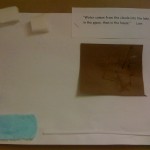 In my last post, we left off with an inquiry about snow and ice, which ultimately led to water. It wasn’t that the students were particularly interested in water, but it seemed a natural segue from ice to water, and I had a particular book in mind that I wanted to read to the class. We had also learned about cycles (big idea) in various forms since October, such as the cycle of the seasons and the weekly cycle and daily cycle. To initiate our topic about water, I first asked the students, “Where does water come from?” Some of the responses were:
In my last post, we left off with an inquiry about snow and ice, which ultimately led to water. It wasn’t that the students were particularly interested in water, but it seemed a natural segue from ice to water, and I had a particular book in mind that I wanted to read to the class. We had also learned about cycles (big idea) in various forms since October, such as the cycle of the seasons and the weekly cycle and daily cycle. To initiate our topic about water, I first asked the students, “Where does water come from?” Some of the responses were:
“Water comes from sinks.”
“Water comes from waterfalls.”
“Water comes from the sky.”
I then read the book titled, All the Water in the World by George Ella Lyon. It is a book that captures childrens’ imagination and interest. I read it to the class a few times. Each time we discussed the descriptive words. We also created a diagram of the water cycle.
At the end of the week, I selected materials that I thought they could use to demonstrate their understanding. The materials were shades of blue paint, white styrofoam, straws, small beads, and construction paper in blue, brown, and black. The children could select from any of these materials, but by controlling the palette I knew the outcome would resemble their intentions.
I asked the students to show where water comes from or where water goes. Their finished works showed their learning and understanding about the water cycle, it also demonstrated their use of language and how effectively they use materials for visual arts.
“Water comes from the clouds into the lake. Then in the pipes, then in the house.” (JK student)
“When we wash our hands it goes from the washroom to the lake through the pipes.” (SK student)
“This is the cloud. The rain drops are coming from it. Down into the lake, into the tubes to the bathtub.” (SK student)
These small projects integrate many subjects and provide the children with authentic learning that they can relate to in the everyday world that surrounds them.



